Roundabouts in cities are a problem. Whilst they are built to simplify traffic flow, they take up a large amount of space, and leave a central area for which it is difficult to find a purpose due to its isolated location.
One such roundabout is at the southern end of Waterloo Bridge, where York Road, Waterloo Road, Stamford Street and the approach to Waterloo Bridge all meet. I photographed the roundabout from the Shell Centre viewing gallery in 1980:

Beneath the roundabout were a large number of pedestrianised access routes to the surrounding streets and the central space provided access between these, so you could walk between any of the surrounding streets without having to cross a road.
It was always a rather bleak space. Concrete planters were scattered around the central space, and for a time in the 1980s the GLC organised what we would now call a pop-up market at lunchtimes, hoping to attract workers from the surrounding offices, although with traffic on the surrounding roundabout, it was not that pleasant and most people headed to the Jubilee Gardens or the walkway alongside the Thames.
A rather innovative use for the central space was found in the late 1990s when the British Film Institute opened an IMAX Theatre in the centre of the roundabout:
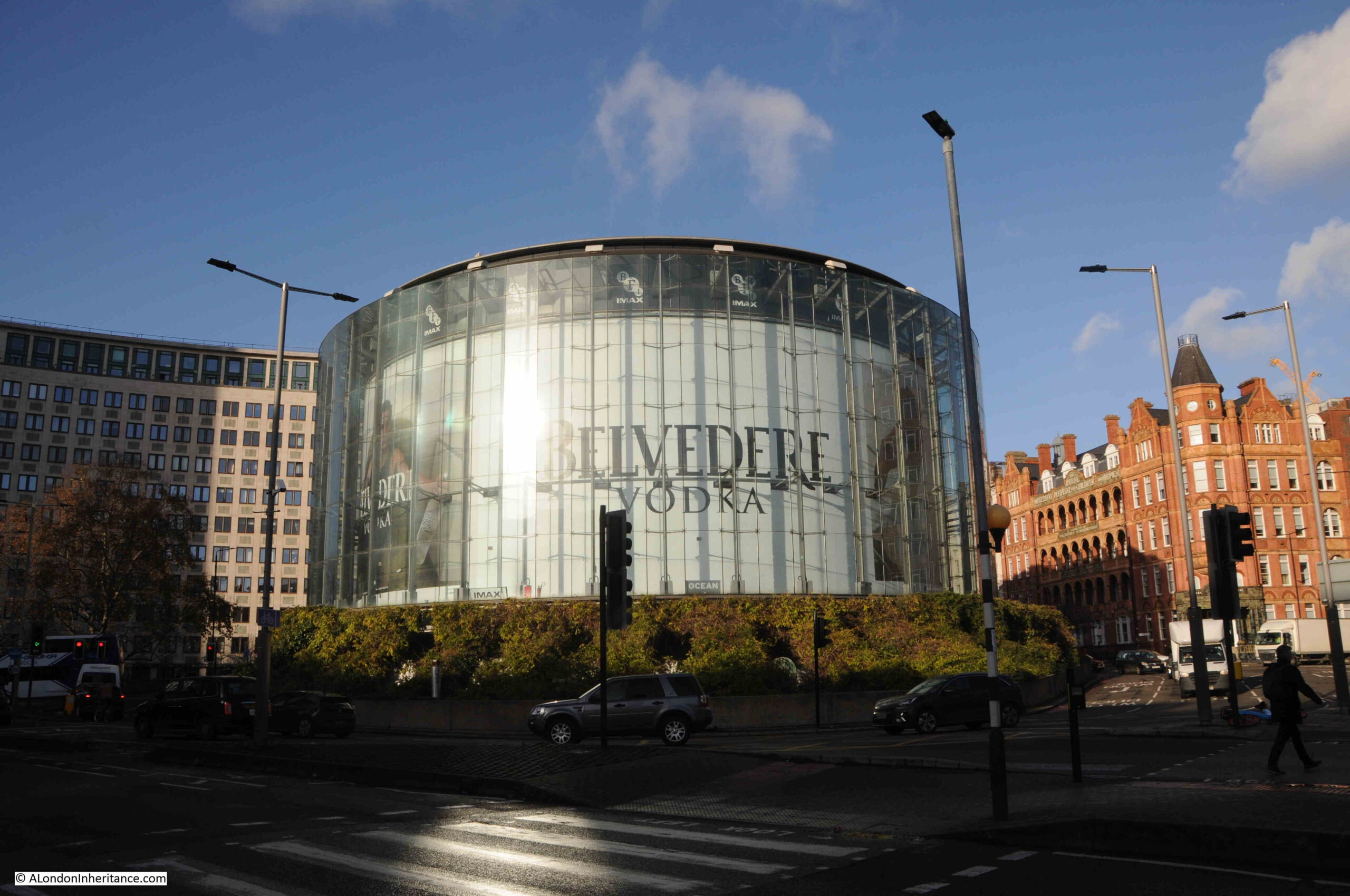
The IMAX is of circular design to fit the central space, and is surrounded by a glass wall which makes the building ideal for advertising and for displaying films that are being shown in the theatre. It is a very obvous landmark when approaching from any of the surrounding streets, and with the low sun of a December day, produces strange light reflections on the streets of the roundabout.
So, a very clever use of a difficult city space. One that has to overcome a number of obstacles, for example vibration and soundproofing from both the traffic on the roundabout, and the Waterloo and City line which runs just 4 metres below the theatre, which gives me an excuse to show a map of the route of the Waterloo and City line, with the location of the roundabout and IMAX marked by a red circle (Credit: The Engineer, July 26, 1895, Public domain, via Wikimedia Commons):
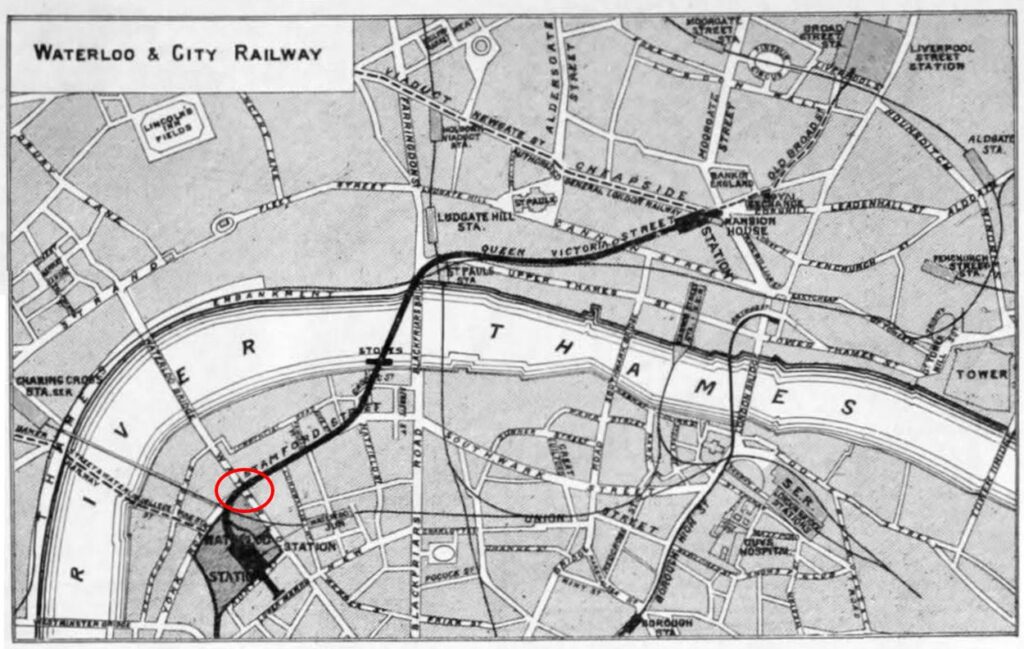
The IMAX Theatre was opened in 1999 and designed by Bryan Avery Architects. I have walked past the IMAX countless times, but what got me thinking about the use of space and the problems of inner city planning and maintenance was when I was walking alongside the roundabout in late December.
Access to the IMAX is via the steps down from the surrounding streets that also provide access between the streets without having to cross at surface level.
The steps down in the following photo are on the side of the roundabout between York Road and Waterloo Road. It was the start of the Christmas school holidays and I noticed a mother and child going down the stairs, then coming up, looking around, walking to another set of stairs, then back to the one in the photo. They were going to the IMAX, but there is no obvious signage and the stairs down do not look the most inviting.
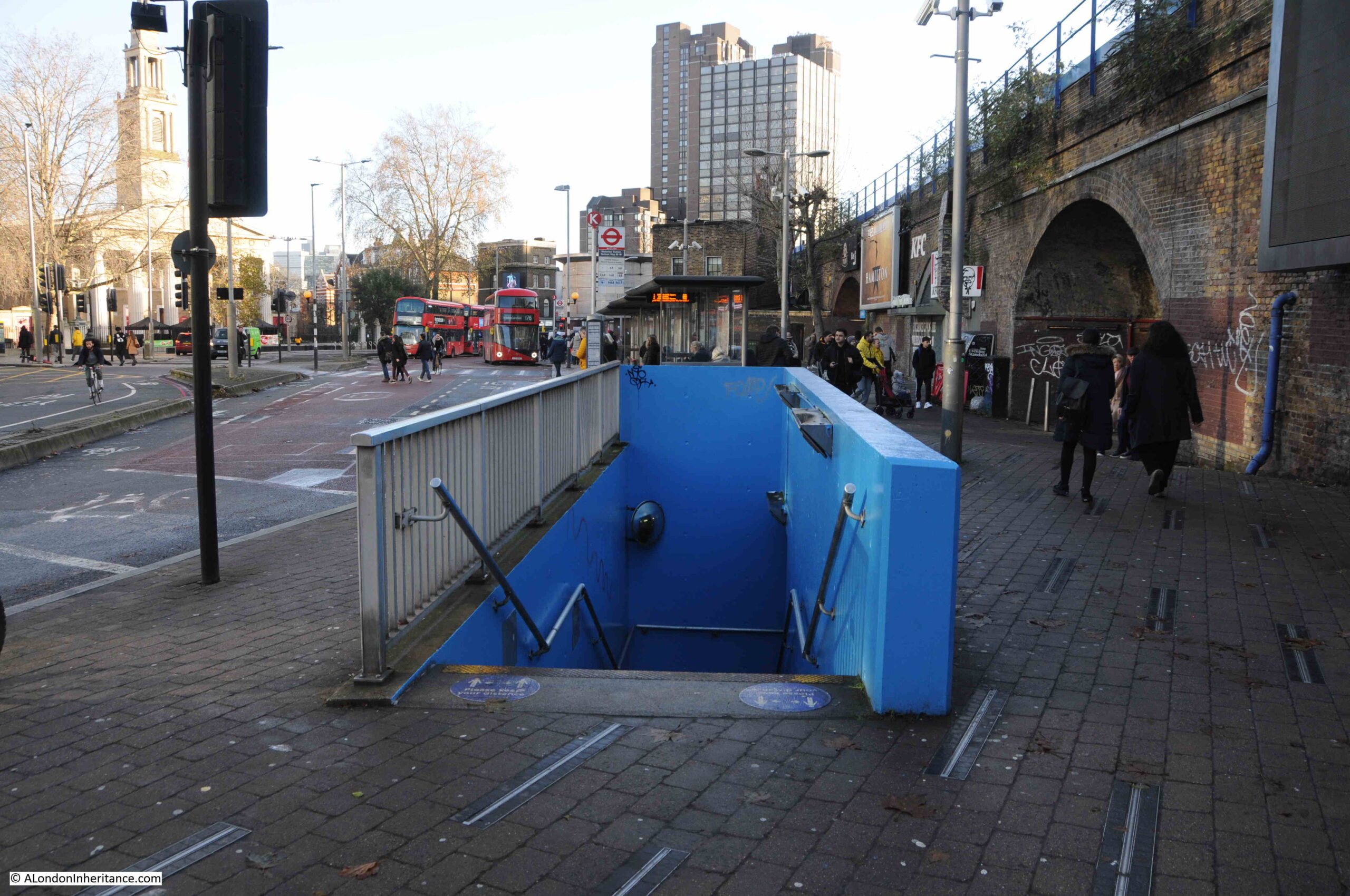
I walked down the stairs, and met the smell that is familiar to such spaces:
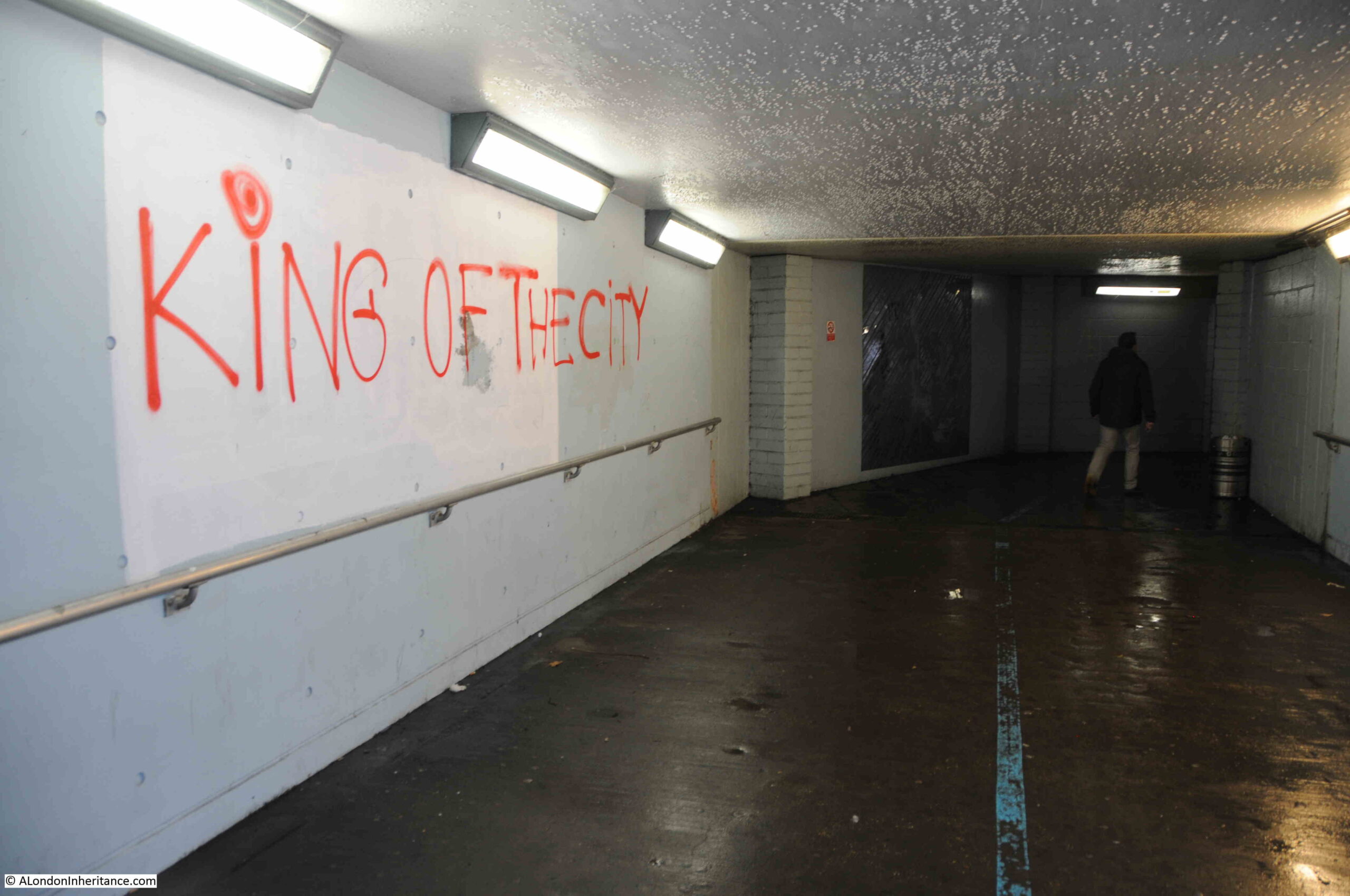
Tunnel under the roundabout leading to the central space and the IMAX:
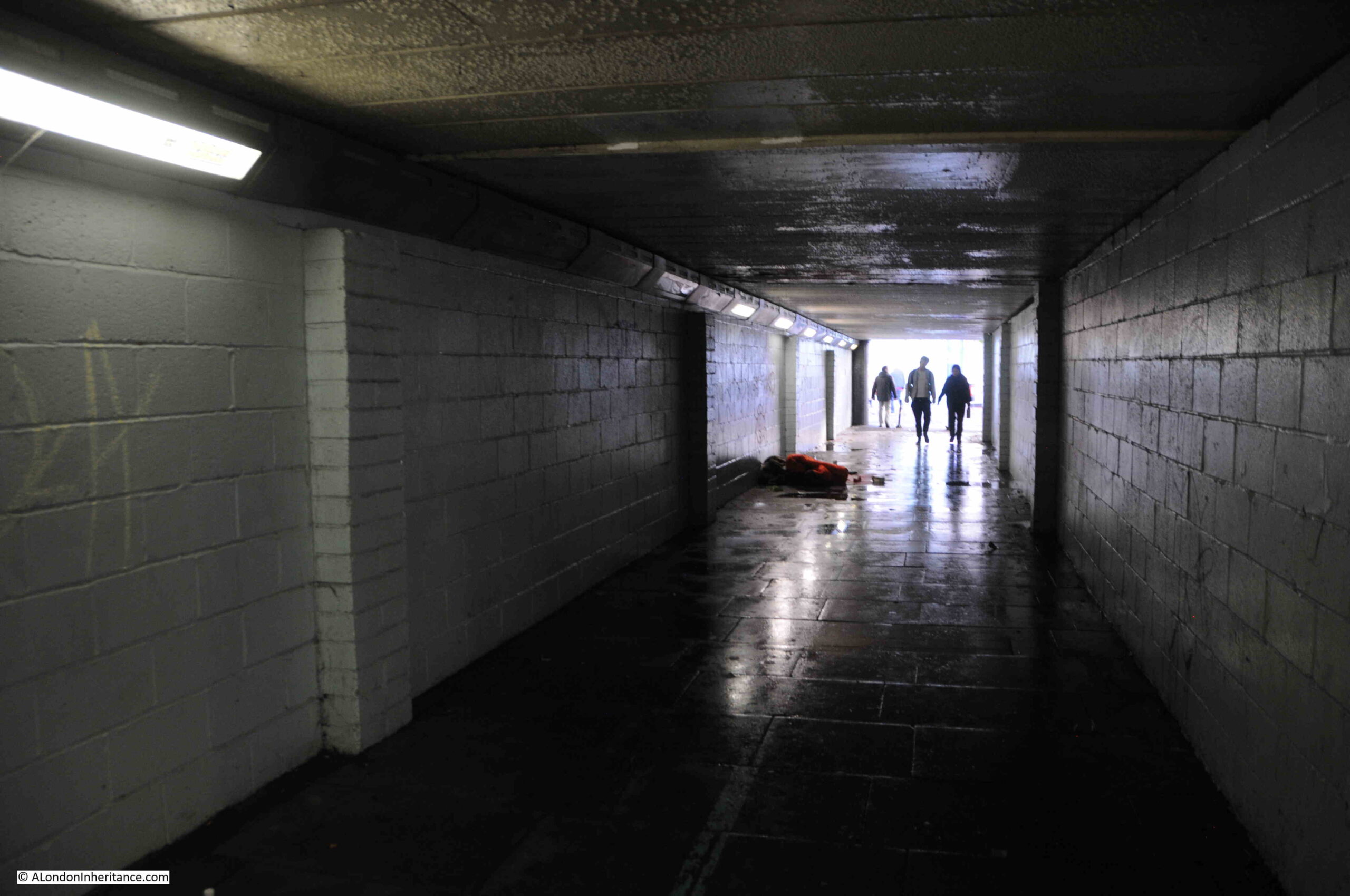
Once in the central space of the roundabout, we can see the curving wall of the IMAX and the extensive planting that creates a rather unique space:

More than 2000 plants were originally planted, comprising of honeysuckle, jasmine, wisteria, clematis, ivy, Boston ivy and Japanese vine. An automated watering system was installed, which looks to have worked well as the plants now look very established and have grown up from the side walls, across supporting cables and up to the sides of the IMAX:

There is a very tenuous link between the current centre of the roundabout, and an earlier use of the space, when it was occupied by Cuper’s Gardens, one of the many gardens and places of entertainment that were found on the south bank of the river in the 17th, 18th and early 19th centuries.
The following map is interesting as it shows the area in 1825, eight years after Waterloo Bridge was opened. It is titled “A Plan of Cuper’s Gardens with part of the Parish of Lambeth in the year 1746 showing also the site of the Waterloo Bridge Road and the new roads adjacent”.
The map helps define the exact location of Cuper’s Gardens as the church of St. John is also shown. The large roundabout (circled) now covers part of Cuper’s Gardens at the junction with Stamford Street:

The “gardens” around the IMAX are very different today, and the whole area is rather a surreal space. The outer wall has been painted light brown, possibly to resemble the earth through which the space descends. Large, twisted trunks (which look like roots) of the presumably now over 20 years growth extend up along the walls, and the outer wall is occasionally cut through with the access tunnels to the streets above:

The entrance to the IMAX Theatre:

Looking up between the planting and the curved glass wall of the IMAX dominates the view:
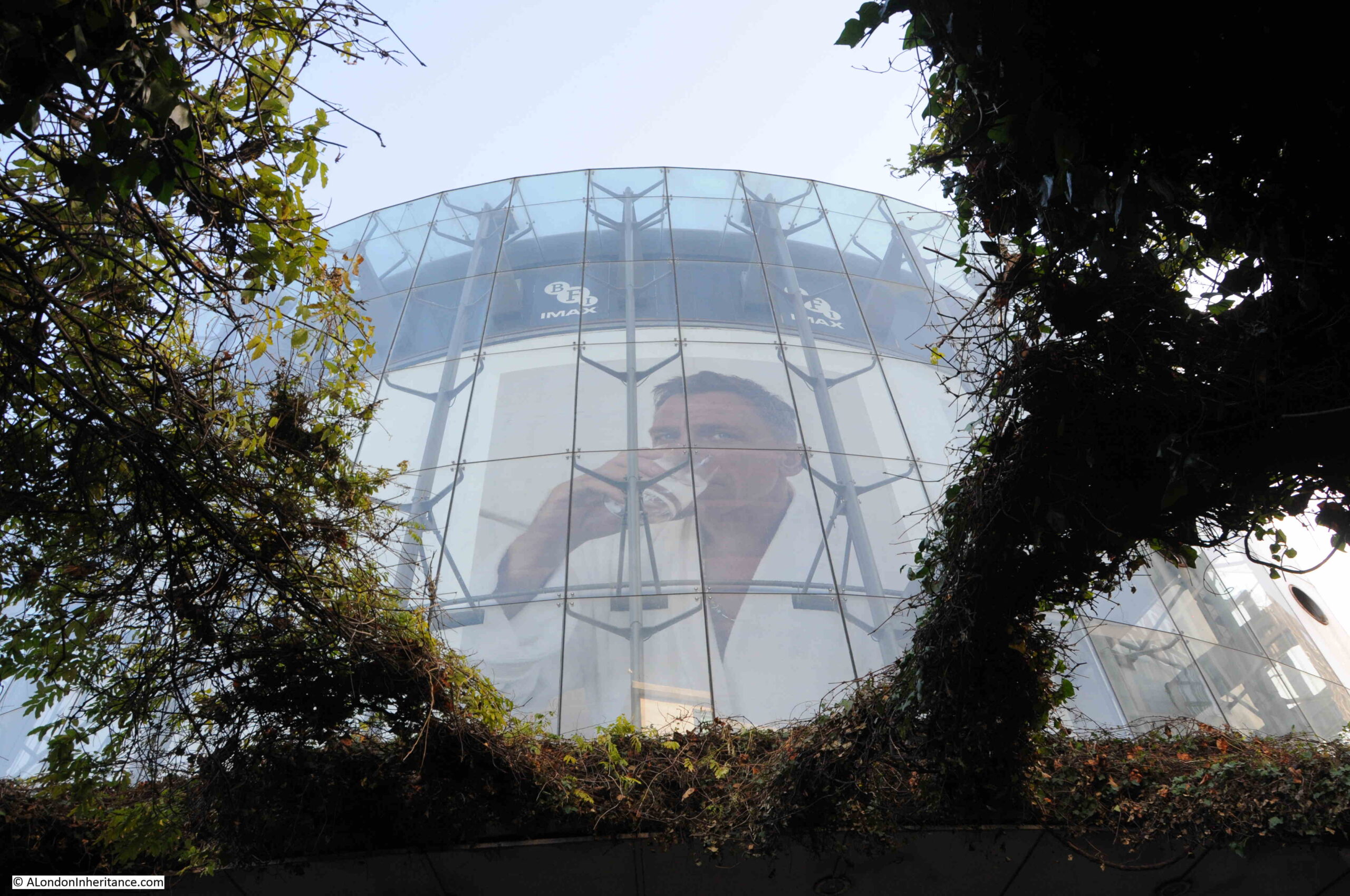
When the IMAX was opened, as well as the central space surrounding the theatre, the walkways and tunnels leading up to the streets were cleaned, restored and painted, with many of the walls being painted blue, and some lighting being set into the walls.
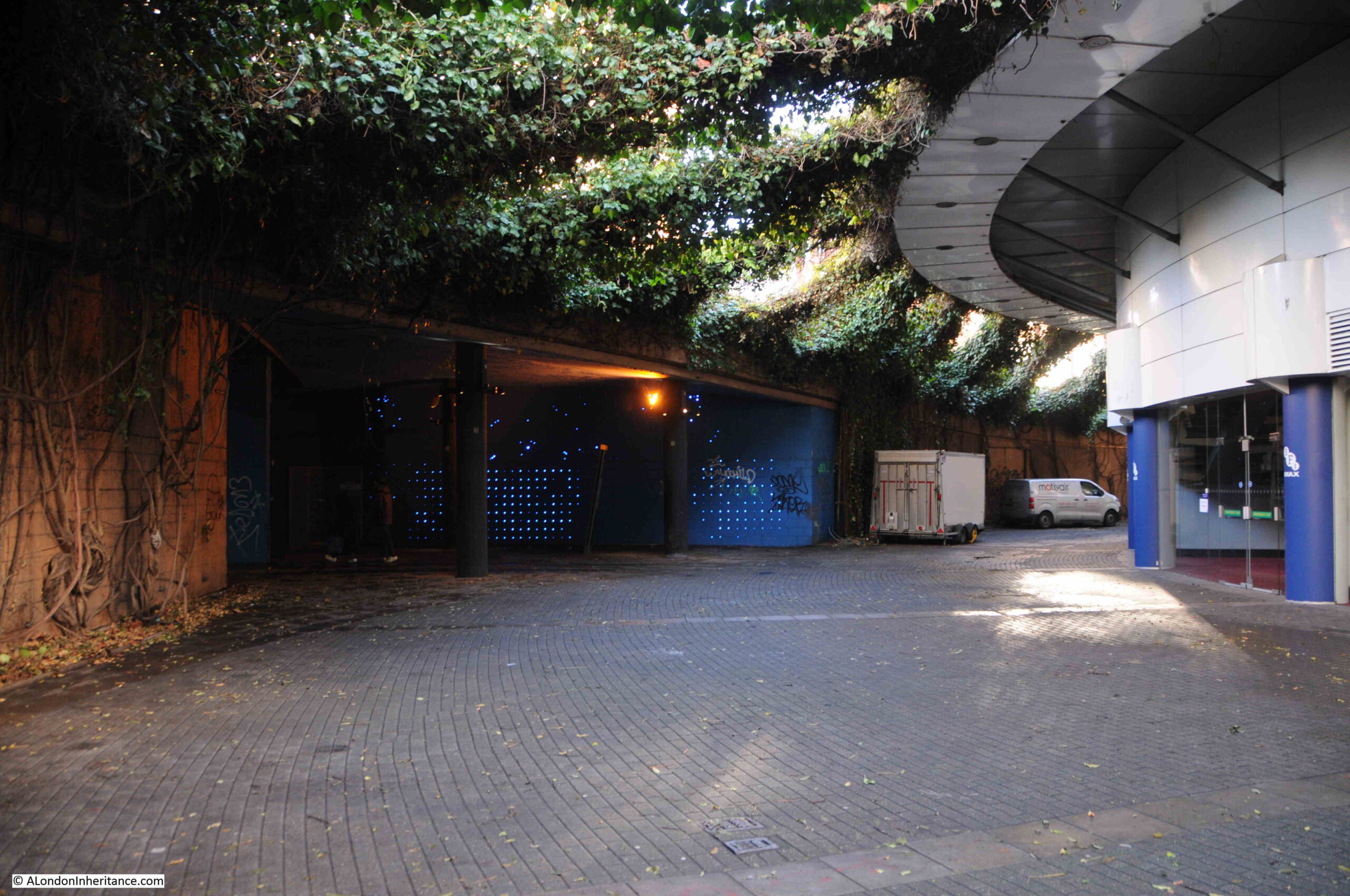
You can see the effect that this was intended to create. The central space with substantial overhead plant growth, the surrounding earth coloured walls, covered in the trunks of the plants, with the walls being cut through by the blue painted walkways to the surrounding streets.
It all creates an intriguing and surreal space, appropriate for walks to the IMAX.
Service access tunnel and pedestrian walkway leading to Belvedere Road:
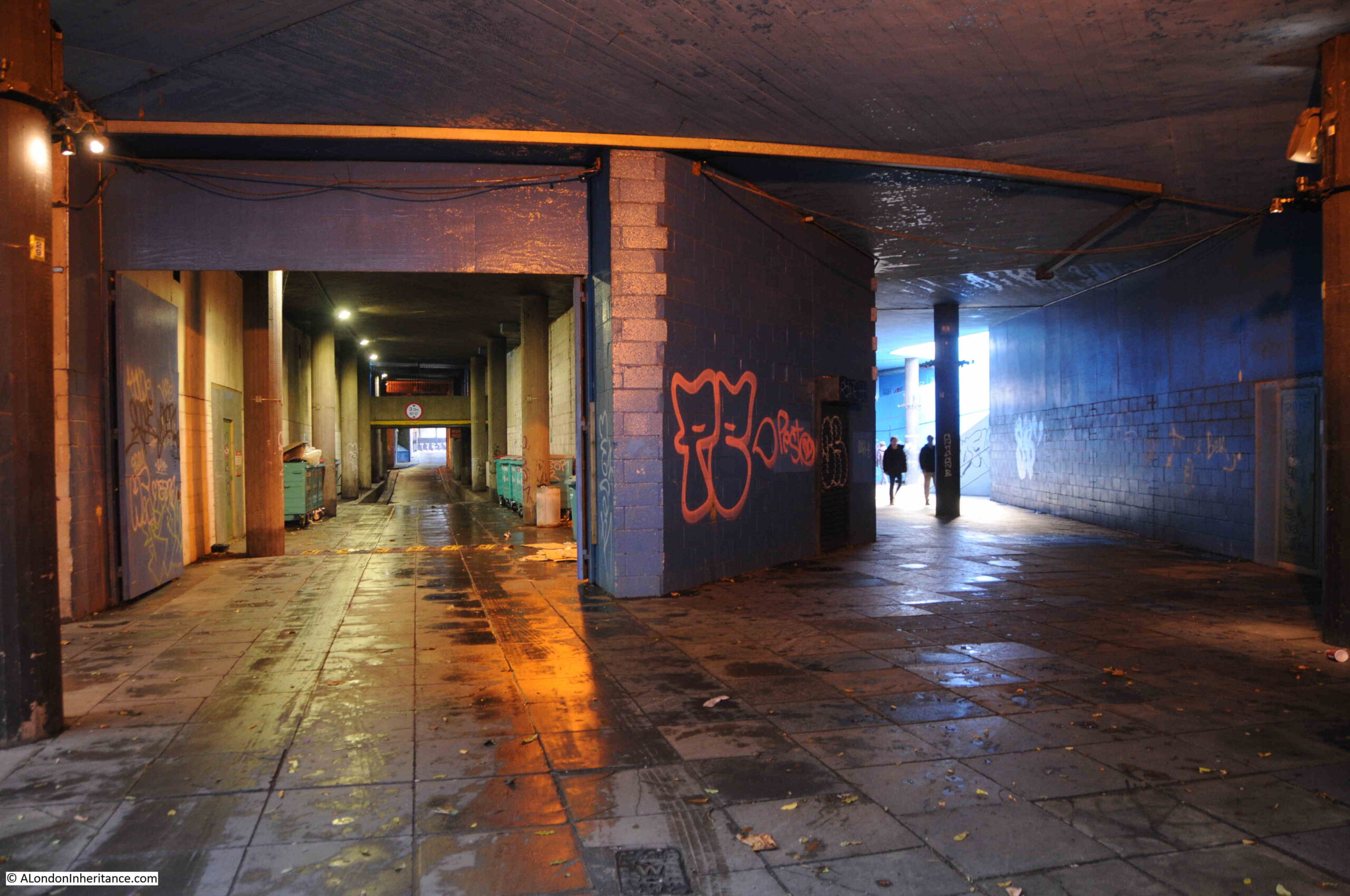
View up through the plants with the new tower blocks that have taken much of the old Shell Centre site:
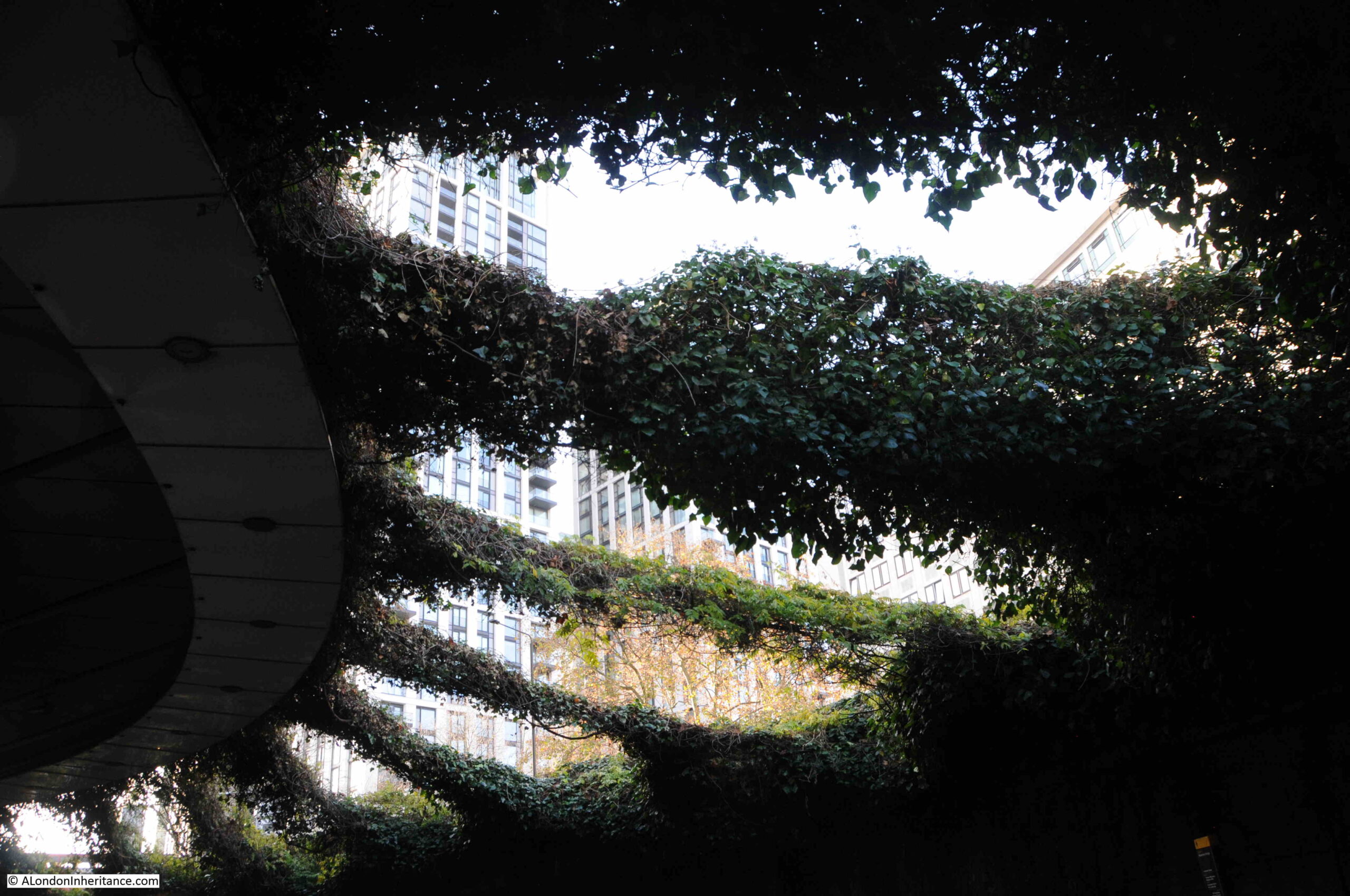
Walking up to the surrounding streets, and it is clear what was intended, and the problems that result in the walkways not being that much of an inviting route to the IMAX. The following photo shows the walkway up to the western side of Waterloo Bridge:
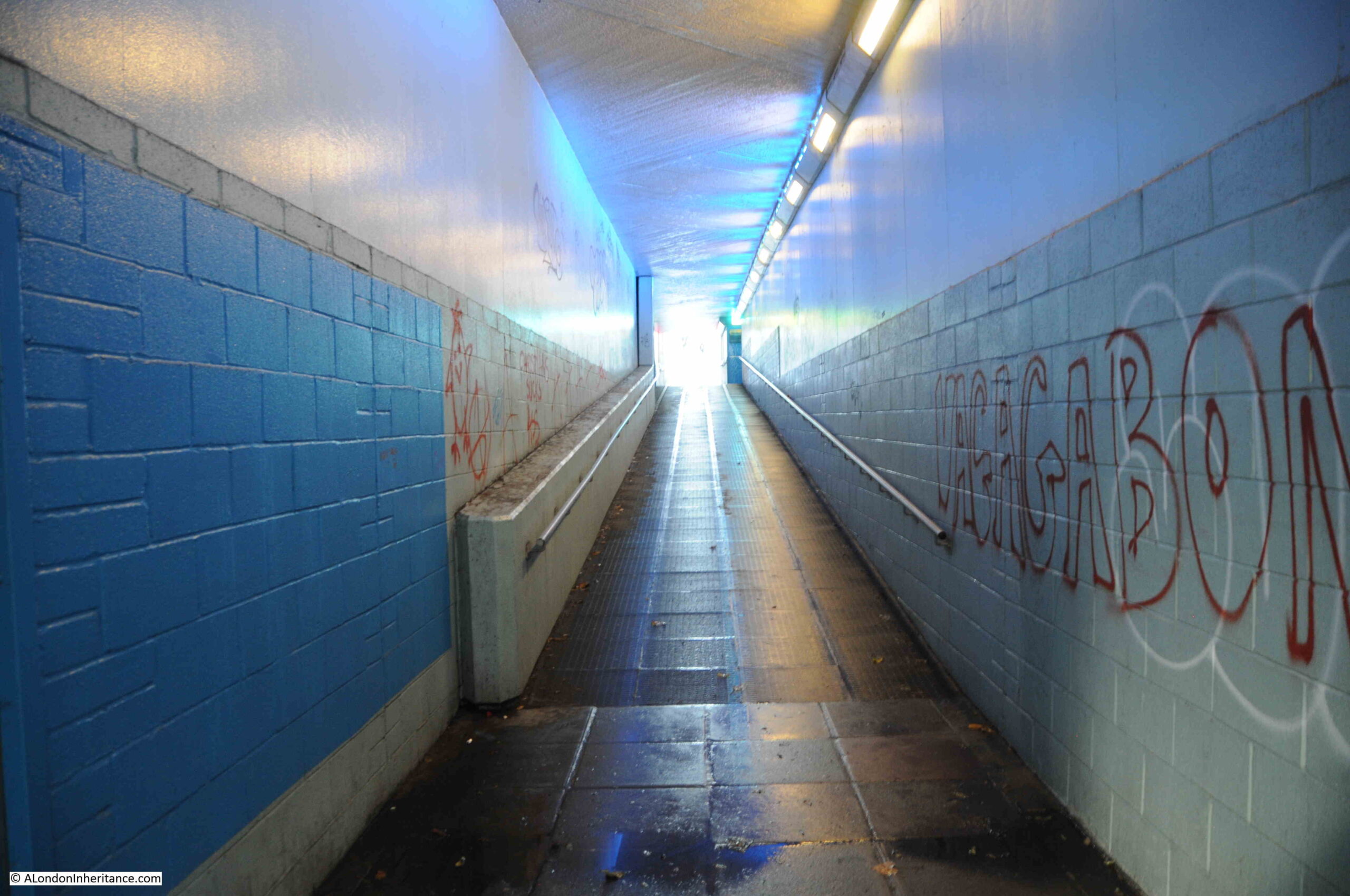
Many of the walls are covered in graffiti, including the main walkway, and the tunnels that connect the east and west walkways:

Many of these walkways and tunnels make really good subjects for photography. The blue walls, the grafitte, and the hidden destination of these tunnels adds to their mystery, however if you did not know the area, were taking children to the IMAX, and it was at night, they are not inviting, and there were very few people using them as I wandered around taking photos.

Global conspiracy theories meet South Bank direction signs:

Looking back down the walkway from the western side of Waterloo Bridge:

Whilst the view of the IMAX in the above photo provides an indication of the destination of the walkway and the tunnel, it does not encourage you to walk down, there should be signs above the tunnel and better lighting in the entrance to the tunnel.
One of the walkways that crosses between the west and east sides of Waterloo Bridges crosses the service tunnel:
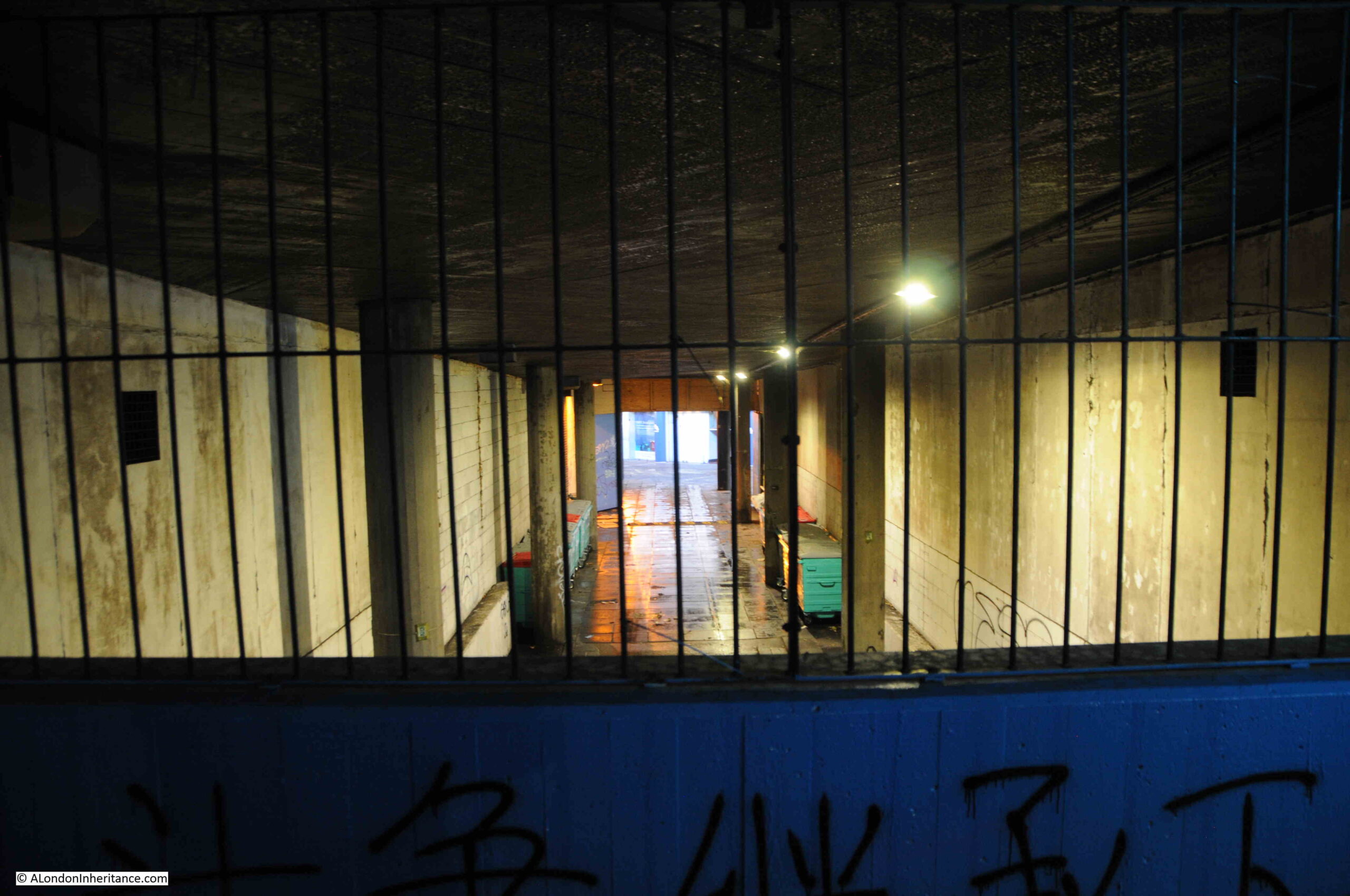
Walkway up to the eastern side of Waterloo Bridge:
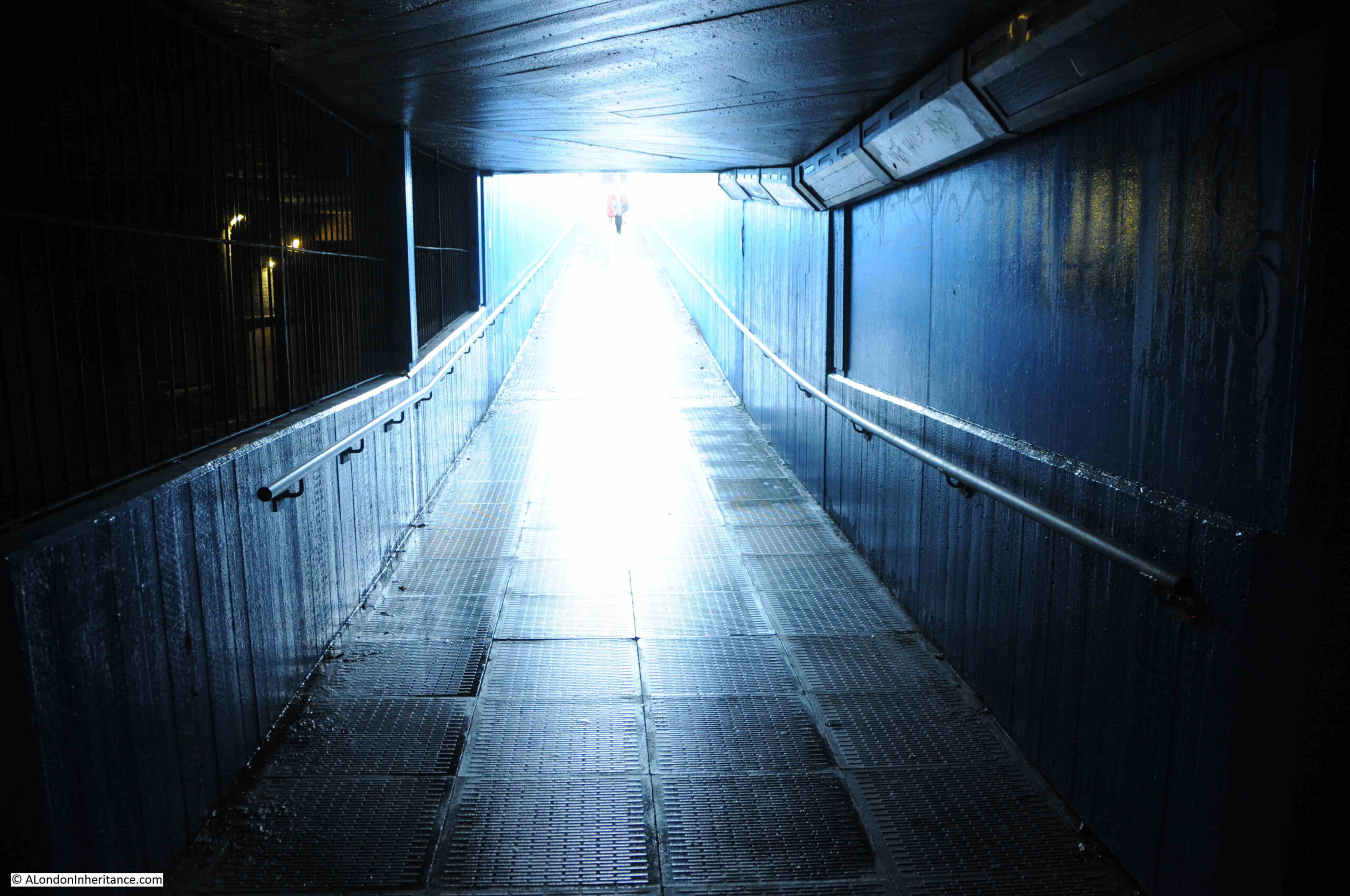
This is the view from the eastern side of Waterloo Bridge, with the IMAX in the centre of the roundabout, and the blue painted entrance to the walkway and tunnels that lead to the IMAX:
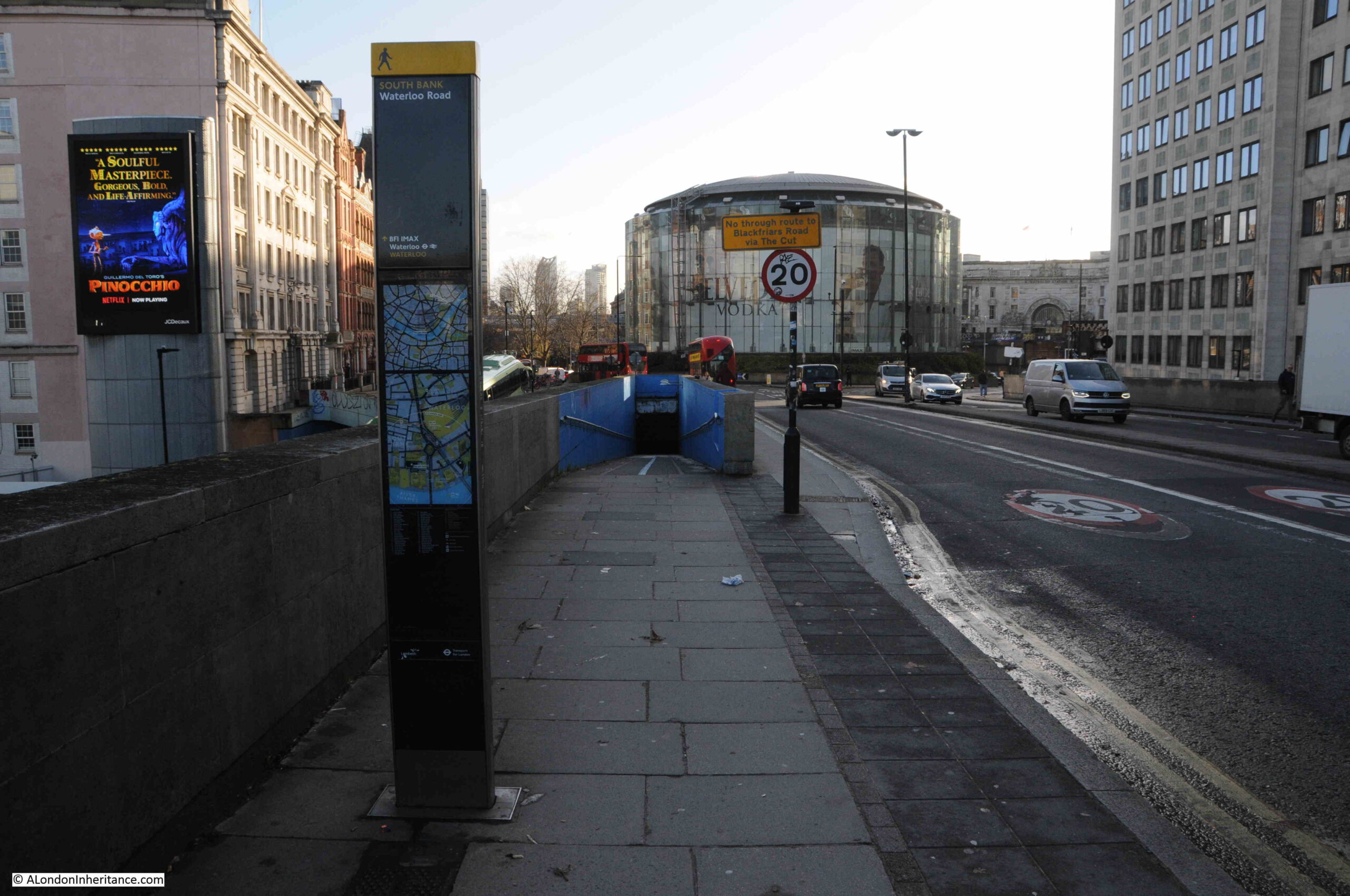
The direction post to the left of the pavement does have a direction to the IMAX with an arrow pointing straight up, the implication being to head down the tunnel rather than walk on the pavement to the right. As with the other entrances, the tunnel does not offer an inviting prospect. No signage above the point where the walkway enters the tunnel and poor lighting at the entrance to the tunnel so it looks very dark and forbidding.
The Waterloo IMAX Theatre is a brilliant use of a difficult space, as well as being a building that has some technically clever ways of avoiding sound and vibrations. For example, the first floor is mounted on oil-damped spring bearings, and the walls inside the glass outer wall are 750mm thick. During construction, pile foundations were installed around the tunnels of the Waterloo and City line. A thick concrete slab was then built on top of the pilings to support the weight of the building above.
The IMAX apparently has the largest screen of any cinema in the UK and has the equipment to support normal film format as well as IMAX Digital and 3D.
A shame that whilst the intention with the tunnels and walkways is clear, and they could have provided a creative and innovative space, what appears to have been limited maintenance and care over the years has resulted in a rather poor experience when walking to the theatre at the centre.
TfL did have plans back in 2017 to transform the area and remove the roundabout, creating a surface level pedestrianised space up to the IMAX, however these plans appear to have been paused due to “the pandemic and current funding restraints”.
Given TfL’s current funding constraints, I suspect the roundabout will be there for some years to come.
More 1980 photos from the viewing gallery of Shell Centre are in this post.

Nice analysis of what’s a very strange area.
I believe it’s now also the single most expensive outdoor advertising site in London.
So right to point this such an uninspiring area besides being by the busiest trainstation in London. The beautiful marble entrance of Waterloo station, The Victory Arch, constructed by James Robb Scott and commemorating Britain’s involvement in World War I is awkwardly obscured behind train tracks on colonaded wall?!?! Dirty undercrofts, grubby glass of the IMAX, traffic lights unsequency and never ending car horns of stolen right of way… my heart us bleeding.
In the 80’s I walked through here daily, between Waterloo and work. There were always rough sleepers asking for cash – and it didn’t feel safe on dark evenings after the rush hour. It is still tatty today, and I avoid it at night. I agree with the previous post that the area around Waterloo is a dreadful, unappealing mess – such a shame.
Another informative & excellent blog, thank you.
Hope Mayor of London reads it. Re the dismal tunnels I suggest a series of walls of water, climbing plants and better lighting. The wall of water preventing graffiti as well as providing irrigation for the plants.
Tried to include a photo but the system wont let me.
Suggest Googling wall if water to see what I mean. Many Local Councils use them
Who ownss those underpasses, and why are they not cleaning them of grot and graffiti? Such a shame.
Very interesting!! It is difficult to know how long these walkways are to get to IMAX? At the least decorative motion sensor solar lights would help and large signs! They could be inviting given a bit of creativity. I wonder how busy the IMAX is? It would be a great museum or real theatre.
Happy new year… A timely post, given the BFI have just wrested back control of the IMAX cinema they built in the first place. You cover the main points of its construction, and some of the contextual issues; you might like to read my own more detailed post, which sets it in the context of the BFI at the turn of the Millennium and the South Bank at the same time. You’ll find out, for example, that “[the] glass wall which makes the building ideal for advertising and for displaying films that are being shown in the theatre” wasn’t actually intended for either… https://www.chrismrogers.net/post/screen-saver
Of course the BFI don’t own or control the roundabout, the subways or the roads and as you rightly point out they are a massive weakness of the concept. The IMAX and main BFI site are only 100m apart but might as well be worlds apart. Hard to see any solution.
I note your instructive and interesting blog the Imax itself being a massive ? draw to the area it is surely in their own interests to make the best use of the area they can. Also as has been observed in the past London city is or should be a tourist destination not just the usual palaces and places tour but the whole city. As well as a town where the populace live and work. As such all interested bodies have an obligation to maintain the area . There are now in use by councils all over the country anti-grafitti paints , although probably more expensive than other finishes it would surely be more economic in the long run to use these. Also in Carlisle a city I know well there is a similar roundabout with entrance tunnels under the surrounding streets where they have used scenes from history to decorate these areas, in fact I believe they gave the whole project over to the local art college at one time thereby giving the youth of the city an investment in its appearance .
I recall that the option to walk at surface level when approaching from Waterloo bridge (see last picture) was not always there. Everyone was funneled underground. The narrow pavement that juts out looks like an add to cope with the fact that many pedestrians would hazard the roadway rather than the tunnel. A demo of how unpopular tunnels are.
Andrew McCabe
Great article , I grew up in Waterloo in the 70s and 80s and remember that roundabout very well as cardboard city!
Great article, well done for celebrating this strange an unusual space. Fascinating to see your 1980 photo. I also have vivid memories of “cardboard city” on the site, which must have been later in the 1980s – see https://en.wikipedia.org/wiki/Cardboard_City_(London) I wonder if anyone managed to make respectful photos of it at that time?
Also, I wonder if some of the underground passages are the same as the ones that connected the former hospital on Stamford Street, now part of KCL, to Waterloo station, and were used to transfer wounded soldiers in WW1?
A very interesting history to research.
I worked at the Shell Centre in the late 1960s and in the lunch hour we used the roundabout to go shopping in The Cut. We never went on our own as even then the tunnels were always a scary place to walk.
Two years ago I went back to the area with my brother, he had worked at County Hall, and we were appalled at how much the area had deteriorated.
Area looks shabby and so run down. Certainly wouldn`t use the tunnels. My father worked in an office based in Stamford street early 1950`s until the company relocated to Orpington Kent.
An interesting article and having worked in Waterloo Bridge House (now occuoied by a university) for 5 years 1991/5, I can only agree with all you said about the stairways and tunnels.More often than not I used to cross the roads above ground on foot. However I was a lot younger then and could dash between vehicles!.
Thanks for all your articles during 2022 and Happy New Year.
My memories are similar to some of the other commentators who made the daily journey from Waterloo Station to Stamford Street and beyond and well recall the wind-swept and open underpasses that later became the location of the cardboard homes for many homeless people. I recall chatting to some of the ‘residents’ whose tales of bad luck or poor choices evoked my sympathy although not all were so approachable. As a young teacher in the mid 1970s I was commended by the Deputy Head of the school in which I worked when he spotted the first piece of graffiti mentioned me by name. It had taken a year to be created but he had decided that I must be doing a good job to have my name inscribed on the walls of the underpass!
Thank you for this interesting article.
You don’t mention that, until very recently (perhaps the last eighteen months ?) there was yet another tunnel entrance immediately outside the main entrance to Waterloo Station. Does anyone know why this was removed ?
Such as the ‘direction post’ in the final picture are part of TfL’s Legible London scheme in being examples of its Monolith or Minilith panels. More details can be found at:-
https://tfl.gov.uk/info-for/boroughs-and-communities/maps-and-signs
As ever, thank you: I look forward to this New Year bringing us all yet more enlightenment!
In the 1980s the roundabout was know as ‘cardboard city’ due to the very large number of homeless people that were sleeping there.
There was discussion about the IMAX site being designated for an office scheme, with funds from the local authority being used for a feasibility study. https://www.london-se1.co.uk/news/view/10591
Remember it pre Imax – a grim place – certainly not recommended to use after dark. Did you ever get to photograph the labyrinth of underground walkways around the roundabout at the Elephant before they got filled in. Nice mosaics as I remember –
I recall (perhaps not accurately) that a similar roundabout was built on at the southern end of Westminster bridge next to the south western corner of the then GLC building. It was a round office block which was used as an office extension for the GLC. A cousin of mine worked in this building in the architects dept. Apparently it was not a popular place to work as the views from the building was of constantly passing traffic all travelling in one direction and it made them feel seasick!.
Many thanks for your great articles. London is quite an interesting place after all! best regards R
The various subways are still very uninviting to what appears a 1st class leisure venue
The landscape architect for the IMAX Cinema was John Medhurst. He says that from the outset of the project (and before his involvement), Avery Architects Associates envisaged planting as a prominent and vital element in the design. Their initial proposals showed the whole building covered in vegetation growing on a spiralling metal structure that also supported a hydroponic system plus automatic leaf trimmers! This didn’t happen, but the aim to green the urban jungle of Waterloo and provide a leafy interlude between the station and the BFI’s National Film Theatre and other cultural destinations on South Bank did come about and successfully so under John Medhurst’s guidance. He worked on this project from 1992-1999. He advised against using a single species of plant on every aspect of the building in different sunlight, shade and wind conditions as the architects had wanted, and he was also opposed to growing all the plants in boxes and it all being totally dependent on irrigation, rather than being planted into the ground. He was proved right on both counts – the planting looks magnificent and a bit audacious as it scrambles across the void. Apparently every public body that it was necessary to consult queried the idea of planting on this roundabout.
John said he hasn’t walked through here for some time and he was disappointed to see in the photos the graffiti and lack of maintenance. Without proper maintenance, designed landscapes can very quickly slide into disrepair, look awful, attract bad behaviour, and then everything gets ripped out and more money is spent on fees and redoing it – or it all goes under the digger. This design is only just over 20 years old… We mustn’t just let it go!
Many of the tunnels used to be much more open than they are now. You can see in some of the photos how one wall is either partly or wholly made of breeze blocks: these are infill added later to partition off what used to be larger areas of open space underneath the roundabout. In some cases this has created storage areas and in others serves to turn what had been open bridge structures above the service areas into enclosed tunnels. It may or may not be an improvement to reverse some of these changes, but there is clearly space there to reimagine the tunnels and passageways beyond just repainting or decorating them.
It’s even worse if you’re doing it step free… Trying to get to the green room bar on upper ground was a trial. The lack of decent signposting is the most obvious, annoying, and cheapest, thing that needs to be fixed!